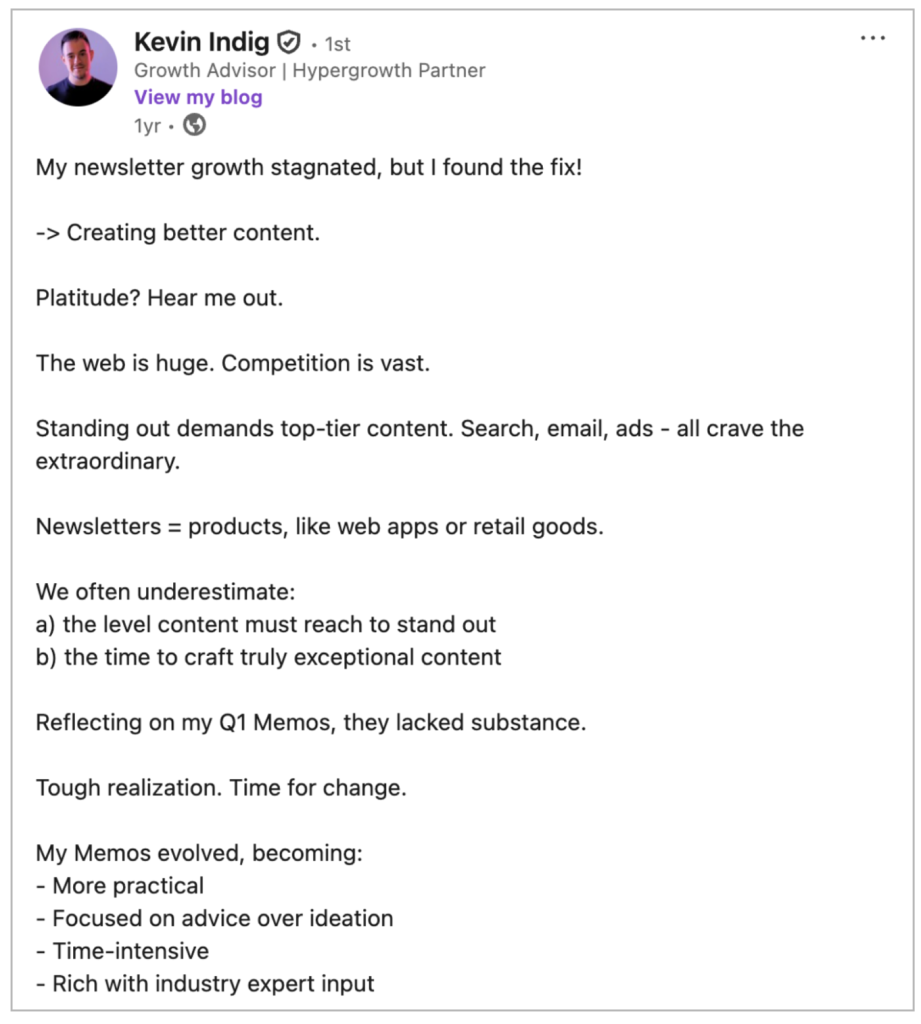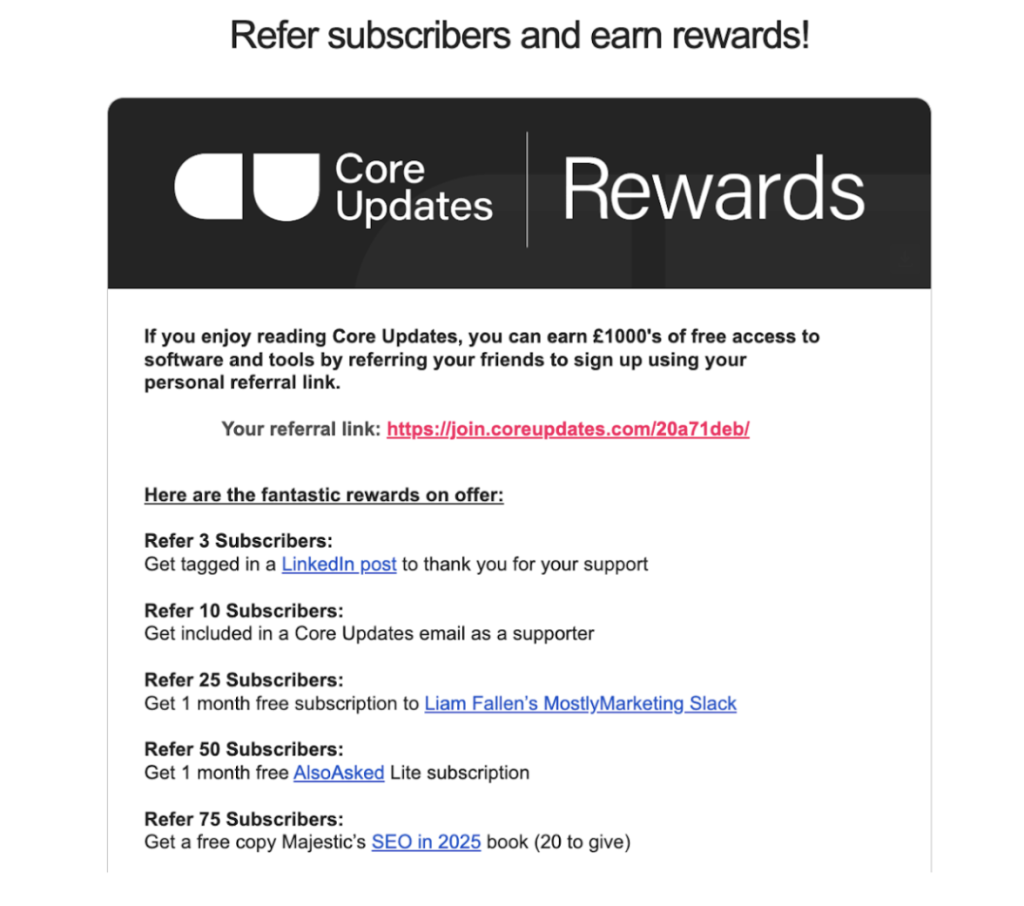Organic traffic is shrinking, especially for informational keywords. Features like Google’s AI Overviews now deliver direct answers, often without users clicking a link.
If your business relies mostly on search, you’re more vulnerable than ever. To survive and thrive, you need to build traffic sources you control.
In this article, I’ll show you what’s changing with organic search, why diversification is critical, and exactly how to create multiple traffic streams that protect your growth for the long term.
What’s happening with organic search?
Generative AI tools like Google’s AI Overviews are fundamentally reshaping search behavior. Instead of clicking on links, users now get direct answers on the search results page itself, which means no need to visit your website.
The impact is brutal:
- When AI Overviews appear, organic click-through rates (CTR) can drop by 50% to 70%.
- Seer’s study found CTRs plunging from 1.41% to just 0.64% when AI results were displayed.
High impressions with few clicks? It may not be your fault, it seems like AI has something to do with it.
For many sites, organic traffic has dropped since the broader rollout. Brands that rely on informational keywords, the very ones AI answers directly, are feeling the deepest cuts.
Why is this a problem?
If users stop clicking, brands lose traffic, leads, and revenue, even if they still rank well.
Even worse, generative AI often pulls information directly from your content, blends it with other sources, and presents it.
While this may include citations, the nature of these AI-generated answers means users frequently get their information directly on the search results page, negating the need to click through to your site. You do the work; the search engine keeps the user.
This raises serious questions about content ownership, fairness, and the sustainability of publishing high-quality content at all.
Bottom line: Relying only on organic search is becoming riskier by the day.
The shift: From SEO to ecosystem building
Clinging solely to organic search today is like building a house on shifting sands. Search engines are still important, but putting all your trust in them leaves you vulnerable to sudden algorithm changes and the growing dominance of AI-generated answers.
Diversifying your traffic sources isn’t just a backup plan; it’s how you build a brand that thrives, no matter how the landscape changes. Here’s what diversification looks like.
Protection against search volatility
While algorithm changes are intended to improve user experience, they can dramatically impact your visibility. A sudden drop in rankings can disrupt your entire business if you don’t have alternative traffic streams.
Diversification cushions that soften the blow by ensuring you still reach your audience, even if one channel dips.
To illustrate the importance of this, Emina Demiri-Watson, Head of Digital Marketing at Vixen Digital, shares a stark reality her clients faced:
“Recently I worked on two different projects hit by HCU [Helpful Content Update] and subsequent updates. Both lost over 50% of their organic search traffic. For one of them, recovery was possible and it included traffic diversification.
This started with reframing what we mean by search. Search is not just search engines, it’s other spaces where your audience searches for your brand, think organic social, forums, YouTube…
We advised them to go back to basics: look at all the spaces their audience is, and gather market intelligence data that helps you understand their behaviors and how your brand fits within it. Only then can they look at how to best diversify – in a strategic way. Not using a pray and spray approach.”
Imagine two brands hit hard by Google’s Helpful Content Update:
- Brand X has a diversified approach, with traffic coming in from Google, e-mail, YouTube, and online communities.
- Brand Y relies solely on Google for traffic (one traffic source) – no backup channels whatsoever.
Whose traffic would collapse if one channel (Google) tanks? Just “don’t put all your eggs in one basket.”
Broader audience reach
Not everyone finds brands through Google. Some audiences are hanging out on TikTok while others search Reddit threads or binge YouTube tutorials.
Showing up in different spaces allows you to meet people earlier in their journey, not just when they’re ready to buy, but when they’re first curious.
- Stronger brand visibility
A single search ranking is one moment of exposure. But what if someone sees your brand in their inbox, on LinkedIn, in a community forum, and YouTube recommendations? You stay top of mind. Repetition across channels builds familiarity, trust, and loyalty. - Lower risk, higher return
When your traffic sources are spread across multiple platforms, a hit in one place hurts less, and wins in another place can be scaled faster.
In fact, you’re not just building traffic streams, you’re building a brand ecosystem. One that survives, adapts, and grows even when Google shifts the goalposts again.
For instance, a home improvement brand might rank for “DIY bathroom remodel” on Google, but get more traction from a YouTube series walking viewers through each step.
That’s broader reach: the same topic, repurposed for a different platform and audience behavior.
[Case Study] How GroupM Turkey helped IKEA increase their non-branded organic traffic
Practical steps to diversify your traffic sources
Breaking free from the constraints of dependence on a single traffic stream requires a strategic and multifaceted approach.
Here’s a breakdown of how you can diversify your traffic sources.
Evaluate your traffic sources
Before diving into new channels, it’s important to understand where your traffic is currently coming from. Too often, businesses charge ahead without this clarity.
As Melissa Popp, a content strategist, points out,
“Failing to answer this basic question often leads companies to over-invest in SEO while missing broader opportunities.”
– Source: Women in TechSEO
Melissa emphasizes that true diversification starts with a deep understanding of your audience — through buyer persona development and market research — before expanding across platforms like social, e-mail, and video.
In other words, diversification isn’t just about adding new channels; it’s about aligning your content to where your audience is already active.
This helps you identify areas where you’re overly reliant on one source, particularly organic search, and will guide where you should focus your efforts.
To evaluate where your traffic is coming from, start by mapping your visitors with analytics tools like Google Analytics, SEMrush, or Serpstat to break down your traffic into categories: direct, organic search, referral, social, paid, and email.
For example, in Google Analytics:
- Navigate to Acquisition > All Traffic > Channels to see the percentage from each source. If you notice that over 70% of your visits come from organic search, you’re at risk of over-reliance.
- Compare your performance with competitors using traffic analytics tools to spot gaps or opportunities for diversification.
- Set a benchmark and set a goal to grow underperforming channels by a specific percentage over the next quarter or so.
![]()
Rethink organic traffic – follow your audience, not just Google.
Organic search itself has diversified beyond just Google. Tory Gray, founder of Gray Dot Co explains,
“The way people ‘search’ today happens across TikTok, Reddit, YouTube, and more.”
Tory’s advice underscores a key point: to effectively diversify, you must follow the data — understanding where your target audience searches for information and tailoring your content accordingly.
It’s not about being everywhere at once; it’s about being strategic, based on user behavior and platform-specific demand signals.
It’s time to shift your search mindset: think beyond the blue links. Your audience’s search bar might be on a social media platform or within a community forum.
If, for example, your target market is Gen Z, platforms like TikTok or Reddit may be a more relevant strategy to increase your brand’s influence. Start by joining relevant subreddits or industry forums, and contribute valuable insights; don’t just promote your site.
We can already see that a number of beauty brands have started targeting Gen Z via TikTok by creating engaging makeup tutorials and trend spotlights, using relevant hashtags that users actively search.
On the other hand, if you find that your audience is active on YouTube, create a video answering a trending question in your niche and include a link to your site in the description.
A software company aiming for developers could focus on creating in-depth technical videos and Q&A sessions on YouTube, optimizing video titles and descriptions with developer-specific keywords.
Track referral traffic from these platforms in your analytics dashboard to measure impact. Brands winning today show up where their audiences are.
E-mail marketing
E-mail remains one of the most reliable and controllable channels for driving traffic and nurturing leads. Beyond social and search channels, owning your traffic should be part of any diversification plan. Newsletters are a prime example.
Kevin Indig is a prime example of an industry veteran that works hard to secure a significant source of traffic through his newsletter.

Source: LinkedIn
Kevin’s example is a reminder that building an owned audience — one that you can reach directly without depending on third-party algorithms — can create a more stable and resilient traffic foundation over time.
To build a sustainable e-mail channel, consider the following:
- Add a signup form to your website offering a valuable incentive, such as a free guide or discount.
- Use a CRM platform to segment your list by interests or behavior. For instance, send product updates to recent buyers and educational content to new subscribers.
- Set up automated workflows. For example, a welcome series that introduces your brand and encourages a first purchase.
- Regularly test subject lines and content with A/B testing and review analytics to see which e-mails drive the most clicks and conversions.
Content marketing
Audit your existing content to find pages that are outdated or underperforming. Refresh these with current data, new insights, and optimized keywords. Create evergreen resources such as how-to guides or tools-that continue to attract traffic over time.
For broader reach, go beyond your website, identify industry blogs that accept guest posts. Pitch a unique topic, write the article, and include a contextual link back to your site.
Collaborate with other brands for joint webinars or co-authored articles to tap into their audiences. Always include clear calls to action within your content to capture new leads. These partnerships help you tap into new audiences and build authority, driving referral traffic from reputable sources.
Paid advertising
Paid channels offer targeted reach and rapid scalability. Experiment with PPC platforms like Google Ads, Bing Ads, and Facebook Ads to reach specific demographics.
- Set a clear objective for your campaign, such as driving traffic, generating leads, or boosting sales.
- Choose the right platform based on your audience: Google Ads for search intent, Facebook or Instagram for visual products, or LinkedIn for B2B.
- Define your target audience using demographics, interests, or behaviors.
- Create compelling ad creatives with a strong call to action and set a daily or total budget.
- Launch your campaign, then monitor key metrics (click-through rate, conversions) and adjust your targeting or messaging based on results.
- Use display and retargeting campaigns (which show ads to people who have already visited your website or interacted with your brand) to stay visible to potential customers who have already shown interest.
For example, an online education platform might use LinkedIn Ads to reach professionals looking to upskill in specific areas.
In the same vein, an e-commerce platform could use Facebook retargeting ads to show users who viewed products but didn’t purchase, reminding them of their interest.
The flexibility of paid traffic allows you to quickly adjust budgets and messaging based on performance, making it a powerful tool for both growth and diversification.
Referral programs
Referral traffic is often highly qualified, as it comes with a built-in layer of trust. Leverage your existing customer base by incentivizing referrals. Create simple, easy-to-share referral programs that reward customers for bringing in new business.
Here’s how you can do this:
- Select a referral program platform to automate tracking and rewards (e.g., WPLoyalty).
- Decide on an incentive that motivates your customers, such as discounts or gift cards.
- Create simple, shareable referral links and provide customers with ready-to-use email or social templates to invite friends.
- Promote your program on your website, in emails, and after purchases.
- Track referrals and reward both the referrer and the new customer when a successful conversion occurs.
- Regularly review analytics to see which channels or customer segments generate the most referrals, and optimize your program accordingly.
- Track referrals to measure program effectiveness and optimize for better results.
One example that comes to mind where we have seen this done well is in SEO Director, Mark Williams Cook’s core updates newsletter:

Measuring and optimizing performance
Traffic diversification isn’t a set-and-forget strategy, continuous measurement and optimization are essential to ensure each channel delivers maximum value.
Track key performance indicators (KPIs) for each channel
Identify the most relevant KPIs for every traffic source. These could include:
- Organic search: Click-through rate (CTR), bounce rate, and keyword rankings.
- E-mail marketing: Open rates, clickthrough rates, and conversion rates.
- Paid advertising: Cost per click (CPC), conversion rate, and return on ad spend (ROAS).
- Referral programs: Number of referrals, referral conversion rate, and customer lifetime value (CLV).
- Social and community engagement: Engagement rate, referral traffic, and follower growth.
Use tools like Google Analytics, your email platform’s reporting dashboard, and ad managers (Google Ads, Facebook Ads) to gather this data regularly.
Use A/B testing to refine campaigns
Test different elements such as headlines, images, calls to action, and targeting criteria to learn what resonates best with your audience.
This could translate into sending two versions of an e-mail with different subject lines to see which gets higher open rates, or experiment with different ad creatives to improve CTR. Use the results to optimize future campaigns and increase ROI.
Adjust budgets and strategies based on performance
Allocate more budget and resources to the channels and campaigns that deliver the best results. If paid ads on Facebook yield a higher conversion rate when compared to Google Ads, consider shifting more spend there.
Similarly, if referral traffic is growing steadily, invest in expanding your referral program.
Regularly review your analytics-monthly or quarterly-and be ready to pivot your strategy based on what the data tells you.
Set up dashboards for real-time monitoring
Create custom dashboards in tools like Data Studio to visualize traffic trends across channels at a glance. This helps you quickly spot drops or spikes in traffic and respond proactively.
Final thoughts
As industry experts and real-world results show, businesses that embrace traffic diversification achieve greater stability, higher revenue, and deeper customer loyalty. The future belongs to brands that are agile, data-driven, and present wherever their audiences choose to engage.
Hopefully the tips above will help you to think beyond Google for your search strategy. However, diversification isn’t a magic wand: it can’t save a brand that lacks authority, trust, or relevance.
In closing, I think it’s important to keep in mind some wise words from Emina Demiri-Watson,
“Sometimes, diversification alone won’t save you. If your brand lacks trust, authority, and genuine value, no amount of traffic from different channels will fix the problem. Diversification works best when it amplifies an already solid brand foundation, not as a last-ditch effort to salvage a failing company.”


